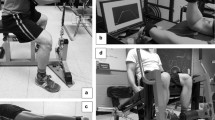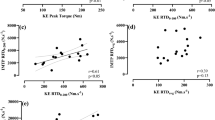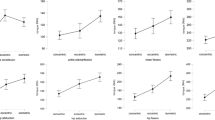Summary
Isometric assessment of muscular function is a popular form of testing which has been used in exercise science for over 40 years. It typically involves a maximal voluntary contraction performed at a specified joint angle against an unyielding resistance which is in series with a strain gauge, cable tensiometer, force platform or similar device whose transducer measures the applied force. Often both the maximum force and the rate of force development are recorded. These tests have generally shown high reliability in both single and multi-joint test protocols, although the maximum force is typically more reliable than rate of force development. This review outlines the reliability of isometric assessment and discusses a number of methodological considerations designed to enhance reliability and validity, including standardisation procedures, type of instructions, muscular pre-tension, testing position and joint angle.
Currently, there appears to be considerable controversy as to the external validity of isometric assessment, particularly the ability of the tests to monitor changes in dynamic performance and their relationship to such performances. Indeed, a number of studies have recently shown that dynamic assessment modalities (isokinetic and isoinertial) are superior in terms of their relationship to dynamic performance and ability to discriminate between athletes of various performance levels compared with isometric assessment.
This article reviews the use of isometric assessment in exercise science and consequently outlines a number of neural, mechanical and methodological factors which may have contributed to the contrasting research, and which may limit the ability of isometric assessment to relate to dynamic movement. Because of the large neural and mechanical differences between isometric and dynamic muscular actions, athletic assessment, which is dynamic in its nature, is generally most appropriately accomplished using dynamic muscular assessment methods, and in most instances isometric testing should be avoided.
Similar content being viewed by others
References
Abe T, Kawakami Y, Ikegawa S, et al. Isometric and isokinetic knee joint performance in Japanese alpine ski racers. J Sports Med Phys Fitness 1992; 32: 353–7
Abernethy P, Wilson G, Logan P. Strength and power assessment: issues, controversies and challenges. Sports Med 1995; 19(6): 401–7
Baer AD, Gersten JW, Robertson BM, et al. Effect of various exercise programs on isometric tension, endurance and reaction time in the human. Arch Phys Med Rehabil 1955; 36: 495–502
Baker D, Wilson G, Carlyon B. Generality versus specificity: a comparison of dynamic and isometric measures of strength and speed-strength. Eur J Appl Physiol 1994; 68: 350–5
Bemben MG, Clasey JL, Massey BH. The effect of the rate of muscle contraction on the force-time curve parameters of male and female subjects. Res Q Exerc Sport 1990; 61: 96–9
Bemben MG, Massey BH, Boileau RA, et al. Reliability of isometric force-time curve parameters for men aged 20 to 79 years. J Appl Sport Sci Res 1992; 6: 158–64
Christ CB, Slaughter MH, Stillman RJ, et al. Reliability of selected parameters of isometric muscle function associated with testing 3 days × 3 trials in women. J Strength Cond Res 1994; 8: 65–71
Clarke HH. Objective strength tests of affected muscle groups involved in orthopaedic disabilities. Res Q Exerc Sport 1948; 19: 118–47
Hakkinen K. Neuromuscular fatigue and recovery in male and female athletes during heavy resistance exercise. Int J Sports Med 1993; 14: 53–9
Hakkinen K, Alen K, Komi PV. Neuromuscular, anaerobic, and aerobic performance characteristics of elite power athletes. Eur J Appl Physiol 1984; 53: 97–105
Hakkinen K, Alen M, Komi PV. Electromyographic and muscle fibre characteristics of human skeletal muscle during strength training and detraining. Acta Physiol Scand 1985; 125: 573–85
Hakkinen P, Komi PV, Alen M. Effect of explosive type strength training on isometric force- and relaxation-time, electromyographic and muscle fibre characteristics of leg extensor muscles. Acta Physiol Scan 1985; 125: 587–600
Hakkinen K, Komi PV, Kauhanen H. Electromyographic and force production characteristics of leg extensor muscles of elite weight lifters during isometric, concentric, and various stretch-shortening cycle exercises. Int J Sports Med 1986; 7: 144–51
Hakkinen K, Komi PV, Tesch PA. Effect of combined concentric and eccentric strength training and detraining on force-time, muscle fiber and metabolic characteristics of leg extensor muscles. Scand J Sport Sci 1981; 3: 509–18
Kovalesci JE, Heitman RH, Trundle TL, et al. Isotonic preload versus isokinetic knee extension resistance training. Med Sci Sports Exer 1995; 27: 895–9
Mero A, Luhtanen P, Viitasalo JT, et al. Relationship between maximal running velocity, muscle fibre characteristics, force production and force relaxation of sprinters. Scand J Sport Sci 1981; 3: 16–22
Murphy AJ, Wilson GJ, Pryor JF. The use of the isoinertial force mass relationship in the prediction of dynamic human performance. Eur J Appl Physiol 1994; 69: 250–7
Murphy AJ, Wilson GJ, Pryor JF, et al. Isometric assessment of muscular function: the effect of joint angle. J Appl Biomech 1995; 11: 205–15
Pryor JF, Wilson GJ, Murphy AJ. The effectiveness of eccentric, concentric and isometric rate of force development tests. J Human Mov Stud 1994; 27: 153–72
Rutherford OM, Jones DA. The role of learning and coordination in strength training. Eur J Appl Physiol 1986; 55: 100–5
Secher NH. Isometric rowing strength of experienced and inexperienced oarsmen. Med Sci Sports Exerc 1975; 7: 280–3
Viitasalo JT, Aura O. Seasonal fluctuation of force production in high jumpers. Can J Appl Sport Sci 1984; 9: 209–13
Wilson GJ, Lyttle AD, Ostrowski KJ, et al. Assessing dynamic performance: a comparison of rate of force development tests. J Strength Cond Res 1995; 9: 176–81
Wilson GJ, Murphy AJ. The efficacy of isokinetic, isometric and vertical jump tests in exercise science. Aust J Sci Med Sport 1995; 27: 62–6
Wilson GJ, Newton RU, Murphy AJ, et al. The optimal training load for the development of dynamic athletic performance. Med Sci Sports Exerc 1993; 25; 1279–86
Young WB, Bilby GE. The effect of voluntary effort to influence speed of contraction on strength, muscular power and hypertrophy development. J Strength Cond Res 1993; 7: 172–8
Atha J. Strengthening muscle. In: Miller DI, editor. Exercise and sport science reviews. Vol. 9. Philadelphia: Franklin Inst. Press, 1981: 1–73
Enoka RM. Neuromechanical basis of kinesiology. 2nd ed. Champaign (IL): Human Kinetics, 1994
Hakkinen K. Force production characteristics of leg extensor, trunk flexor and extensor muscles in male and female basketball players. J Sports Med Phys Fitness 1987; 31: 325–31
Viitasalo JT, Saukkonen S, Komi PV. Reproducibility of measurements of selected neuromuscular performance variables in man. Electromyogr Clin Neurophysiol 1980; 20: 487–501
Tidow G. Aspects of strength training in athletics. N Stud Athletic 1990; 1: 93–110
Going SB, Massey BH, Hoshizaki TB, et al. Maximal voluntary isometric force production characteristics of skeletal muscle in children 8–11 years. Res Q Exerc Sport 1987; 58: 115–23
Strass D. Force-time and electromyographical characteristics of arm shoulder muscles in explosive type force production in sprint swimmers. J Swim Res 1991; 7: 19–27
Mueller K, Schmidtbleicher D. Innervation pattern of isometric and concentric contractions of human triceps brachii during elbow extensions. In: Jonsson B, editor. Biomechanics X-A. Champaign (IL): Human Kinetics, 1987: 479–83
Sleivert GG, Wenger HA. Reliability of measuring isometric and isokinetic peak torque, rate of torque development, integrated electromyography, and tibial nerve conduction velocity. Arch Phys Med Rehab 1992; 75: 1315–21
Mueller K, Buehrle M. Comparison of static and dynamic strength of the arm extensor muscles. In: Johnson B, editor. Biomechanics X-A. Champaign (IL): Human Kinetics, 1987: 501–5
Ryushi T, Hakkinen K, Kauhanen H, et al. Muscle fibre characteristics, muscle cross-sectional area and force production in strength athletes, physically active males and females. Scand J Sport Sci 1988; 10: 7–15
Thorstensson A, Larsson L, Tesch P, et al. Muscle strength and fiber composition in athletes and sedentary men. Med Sci Sports Exerc 1977; 9: 26–30
Garfinkel S, Cafarelli E. Relative changes in maximal force, EMG, and muscle cross-sectional area after isometric training. Med Sci Sports Exerc 1992; 24: 1220–7
Viitasalo JT. Effects of pretension on isometric force production. Int J Sports Med 1982; 3: 149–52
Clarke DH. Force-time curves of voluntary muscular contraction at varying tension. Res Q Exerc Sport 1968; 39: 900–7
Behm DG, Sale DG. Intended rather then actual movement velocity determines velocity-specific training response. J Appl Physiol 1993; 7: 359–68
Wood GA, Singer KP, Cresswell AG. Electro-mechanical adaptation to muscular strength training. In: Klavera P, editor. Proceedings of the North American Congress in Biomechanics; 1986 Aug 25–27: Montreal. Toronto: University of Toronto, 1986: 25–6
Doss WS, Karpovich PV. A comparison of concentric, eccentric, and isometric strength of elbow flexors. J Appl Physiol 1965; 20: 351–3
Sale DG. Testing strength and power. In: MacDougall J, Wenger H, Green H, editors. Physiological testing of the high-performance athlete. Champaign (IL): Human Kinetics, 1991: 21–103
Singh M, Karpovich PV. Isotonic and isometric forces of forearm flexors and extensors. J Appl Physiol 1966, 21: 1435–7
Hakkinen K, Keskinen KL. Muscle cross-sectional and voluntary force production characteristics in elite strength and endurance trained athletes and sprinters. Eur J Appl Physiol 1989; 59: 215–20
Murphy AJ, Wilson GJ. Poor correlations between isometric tests and dynamic performance: relation to muscle activation. Eur J Appl Physiol. In press
Sale DG, Martin JE, Moroz DE. Hypertrophy without increased isometric strength after weight training. Eur J Appl Physiol 1992; 64: 51–5
Hinson M, Rosentweig J. Comparative electromyographic values of isometric, isotonic and isokinetic contraction. Res Q Exerc Sport 1973; 44: 71–8
Viitasalo JT, Hakkinen K, Komi PV. Isometric and dynamic force production and muscle fibre composition in man. J Hum Mov Stud 1981; 7: 199–209
Clarke HH. Application of measurement to health and physical education. 2nd ed. New York: Prentice Hall Inc, 1953: 176
Ikai M, Fukunaga T. Calculation of muscle strength per unit cross-sectional area of human muscle by means of ultrasonic measurement. Int Z Angew Physiol 1968; 26: 26–32
Thompson MW, Janse de Jong XK, Hunter SK, et al. Maximal voluntary isometric strength and anatomical cross sectional area of the quadriceps of young women. In: Book of Abstracts, Sport Medicine Australia’s Conference of Science and Medicine in Sport; 1995 Oct 17–20; Hobart, Australia
Tesch P, Karlsson J. Isometric strength performance and muscle fibre type in man. Acta Physiol Scand 1978; 103: 47–51
Thorstensson A, Grimby G, Karlsson J. Force velocity relations and fiber composition in human knee extensor muscle. J Appl Physiol 1976; 40: 12–6
Viitasalo JT, Komi PV. Force-time characteristics and fiber composition in human leg extensor muscles. Eur J Appl Physiol 1978; 40: 7–15
Jaric S, Ristanovic D, Corcos DM. The relationship between muscle kinematic parameters and kinematic variables in a complex movement. Eur J Appl Physiol 1989; 59: 370–6
Bloomfield J, Blanksby BA, Ackland TR, et al. The influence of strength training on overhead throwing velocity of elite water polo players. Aust J Sci Med Sport 1990; 22: 63–7
Considine W, Sullivan W. Relationship of selected tests of leg strength and leg power on college men. Res Q Exerc Sport 1973; 44: 404–15
Berger R. Comparison of static and dynamic strength increases. Res Q Exerc Sport 1962; 33: 329–33
Fry AC, Kraemer WJ, Weseman CA, et al. Effects of an off-season strength and conditioning program on starters and non-starters in women’s collegiate volleyball. J Appl Sport Sci Res 1991; 5: 174–81
Anderson MA, Gieck JH, Perrin D, et al. The relationship among isometric, isotonic, and isokinetic concentric and eccentric quadriceps and hamstring force and three components of athletic performance. J Orthop Sports Phys Ther 1991; 14(3): 114–20
Takei Y. Techniques used by elite women gymnasts performing the handspring vault at the 1987 Pan American Games. Int J Sport Biomech 1990; 6: 29–55
Mero A, Komi PV, Gregor RJ. Biomechanics of sprint running. Sports Med 1992, 13: 376–92
Aura O, Viitasalo JT. Biomechanical characteristics of jumping. Int J Sport Biomech 1989; 5: 89–98
Komi PV. Physiological and biomechanical correlates of muscle function: effects of muscle structure and stretch-shortening cycle on force and speed. In: Terjung RL, editor. Exerc Sport Sci Rev. Vol. 12. Toronto (DC): Heath, 1984: 81–122
Cohen J. Statistical power analysis for the behavioural sciences. 2nd ed. Hillsdale (NJ): Lawerence Erlbaum, 1988
Kraemer WJ, Fry AC. Strength testing: development and evaluation of methodology. In: Physiological assessment of human fitness. Maud PJ, Foster C, editors. Champaign (IL): Human Kinetics, 1995: 115–38
Sleivert GG, Backus RD, Wenger HA. The influence of a strength-sprint training sequence on multi-joint power output. Med Sci Sports Exerc 1995; 27: 1655–65
Fry AC, Kraemer WJ, van Borselen F, et al. Performance decrements with high-intensity resistance exercise overtraining. Med Sci Sports Exerc 1994; 26: 1165–73
Komi PV, Suominen H, Heikkinen E, et al. Effects of heavy resistance and explosive-type strength training methods on mechanical, functional, and metabolic aspects of performance. Exerc Sport Biol 1982; 92–102
Kanehisa H, Miyashita M. Effect of isometric and isokinetic muscle training on static strength and dynamic power. Eur J Appl Physiol 1983; 50: 365–71
O’Shea KL, O’Shea JP. Functional isometric weight training: it’s effects on dynamic and static strength. J Appl Sport Sci Res 1989; 3: 30–3
Henry FM, Whitley JD. Relationships between individual differences in strength, speed, and mass of an arm movement. Res Q Exerc Sport 1960; 31: 24–33
Nakazawa K, Kawakami Y, Fukunaga T, et al. Differences in activation patterns in elbow flexors during isometric, concentric and eccentric contractions. Eur J Appl Physiol 1993; 66: 214–20
Tax AAM, Denier van der Gon JJ, Erkelens CJ. Differences in coordination of elbow flexor muscles in force tasks and in movement tasks. Exp Brain Res 1990; 81: 567–72
Ter Haar Romeny BM, Denier van der Gon JJ, Gielen CAM. Changes in recruitment order of motor units in the human biceps muscle. Exp Neurol 1982; 78: 360–8
Ter Haar Romeny BM, Denier van der Gon JJ, Gielen CAM. Relationship between location of a motor unit in the human biceps brachii and its critical firing levels for different tasks. Exp Neurol 1984; 85: 631–50
Hasan Z, Enoka RM. Isometric torque — angle relationship and movement-related activity of human elbow flexors: implications of the equilibrium-point hypothesis. Exp Brain Res 1985; 59: 441–50
Howard JD, Hoit JD, Enoka RM, et al. Relative activation of two human flexors under isometric conditions: a cautionary note concerning flexor equivalence. Exp Brain Res 1986; 62: 199–202
Van Zuylen EJ, Gielen CM, Denier van der Gon JA. Coordination and inhomogeneous activation of human arm muscles during isometric torques. J Neurophysiol 1988; 60: 1523–48
Asmussen E, Bonde-Petersen F. Storage of elastic energy in skeletal muscles in man. Acta Physiol Scand 1974; 91: 385–92
Komi PV, Bosco C. Utilization of stored elastic energy in leg extensor muscles by men and women. Med Sci Sports Exerc 1978; 10: 261–5
Wilson GJ, Wood GA, Elliott BC. Optimal stiffness of the series elastic component in a stretch shorten cycle activity. J Appl Physiol 1991; 70: 825–33
Wilson GJ, Murphy AJ, Pryor JF. Musculo-tendinous stiffness: its relationship to eccentric, isometric and concentric performance. J Appl Physiol 1994; 76: 2714–9
Costill D, Miller S, Myers W, et al. Relationship among selected tests of explosive strength and power. Res Q Exerc Sport 1968; 39: 785–7
Rasch P. Relationship between maximum isometric tension and maximum isotonic elbow flexion. Res Q Exerc Sport 1957; 28: 85
Enoka RM. Muscle strength and its development: new perspectives. Sports Med 1988; 6: 146–68
Author information
Authors and Affiliations
Corresponding author
Rights and permissions
About this article
Cite this article
Wilson, G.J., Murphy, A.J. The Use of Isometric Tests of Muscular Function in Athletic Assessment. Sports Med 22, 19–37 (1996). https://doi.org/10.2165/00007256-199622010-00003
Published:
Issue Date:
DOI: https://doi.org/10.2165/00007256-199622010-00003




